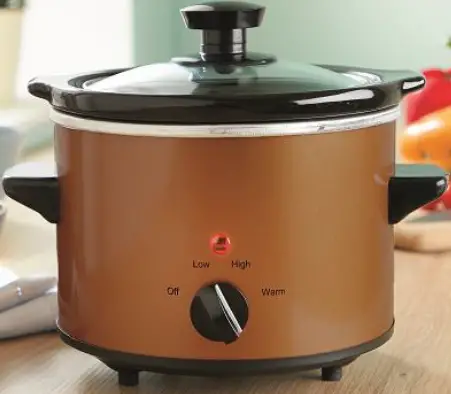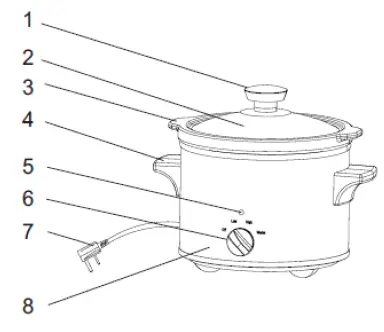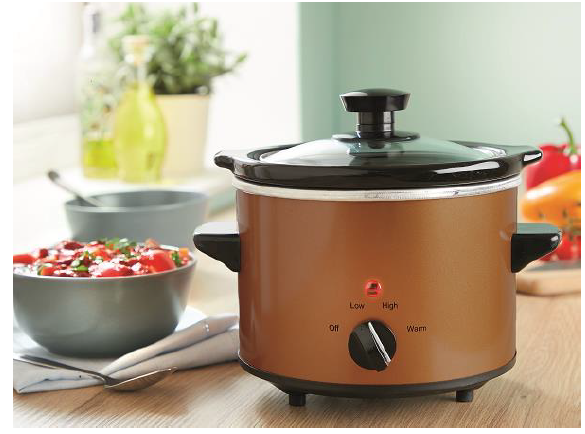Coopers G677 1.5L Mini Slow Cooker


Technical details230-240V a.c., 50-60Hz, 100WDimensions24.5cm *20.5cm *19cmMaterials:Cold rolled steel
- 1.5L – compact smaller size, perfect for 1-2 people
- Removable washable ceramic pot
- 3 heat settings, low warm + high
- On + off indicator light
- Tempered glass lid / Non skid feet
- Cooks meal for 2 4-6 hours on high.
- Space saving, uses less worktop space than bigger models
- Twin-handled pot lifts out for serving at the table / 100W
CAUTION! THIS ELECTRICAL APPLIANCE’S EXTERNAL SURFACES WILL GET HOT IN NORMAL USE. ALLOW TO COOL BEFORE TOUCHING THE EXTERNAL SURFACES. USE OVEN GLOVES WHEN OPENING THE GLASS DOOR WHEN REMOVING COOKED FOOD.
ASSEMBLY INSTRUCTIONS / INSTRUCTIONS FOR USE:Unpack the components carefully. Please check all parts have been removed from the packaging.
SAFETY INSTRUCTIONS:
WHEN USING ELECTRICAL APPLIANCES, BASIC SAFETY PRECAUTIONS SHOULD ALWAYS BE FOLLOWED:
- READ ALL INSTRUCTIONS BEFORE USE.
- DO NOT TOUCH HOT SURFACES TO AVOID BURNS. USE HANDLES OR KNOBS. USE POTHOLDERS OR OVEN GLOVES WHEN REMOVING COVER OR HANDLING HOT CONTAINERS.
- TO PROTECT AGAINST ELECTRIC SHOCK, DO NOT IMMERSE CORD, PLUG OR APPLIANCE, IN WATER OR ANY OTHER LIQUID.
- UNPLUG FROM OUTLET WHEN NOT IN USE AND BEFORE CLEANING.
- DO NOT OPERATE ANY APPLIANCE WITH A DAMAGED CORD OR PLUG OR AFTER THE APPLIANCE MALFUNCTIONS, OR HAS BEEN DAMAGED IN ANY MANNER. WE RECOMMEND THAT THE POWER CORD IS NOT KINKED OR STORED IN A TWISTED MANNER, AND THAT YOU REGULARLY CHECK ITS CONDITION.
Instructions for Use
- THE USE OF ANY ACCESSORY ATTACHMENTS NOT RECOMMENDED BY COOPERS OF STORTFORD MAY CAUSE INJURIES AND INVALIDATE ANY WARRANTY YOU MAY HAVE.
- DO NOT USE OUTDOORS.
- DO NOT LET CORD HANG OVER THE EDGE OF A TABLE OR COUNTER, OR TOUCH HOT SURFACES.
- DO NOT PLACE ON OR NEAR HEAT SOURCES.
- USE ON A LEVEL, STABLE SURFACE.
- EXTREME CAUTION MUST BE USED WHEN MOVING AN APPLIANCE CONTAINING HOT FOOD, WATER OR OTHER HOT LIQUIDS TO REDUCE THE RISK OF BURNS OR INJURY TO HANDS AND LIMBS.
- LIFT AND OPEN THE COVER CAREFULLY TO AVOID SCALDING AND TO ALLOW HOT CONDENSATION TO DRIP BACK INTO THE UNIT.
- TO DISCONNECT, TURN CONTROL TO OFF, THEN REMOVE PLUG FROM WALL SOCKET.
- STONEWARE POTS ARE DESIGNED FOR USE WITH THIS APPLIANCE ONLY. THEY MUST NEVER BE USED ON A STOVE, AS IT WILL CRACK AND CAN CAUSE BURNS IF THERE ARE HOT LIQUIDS OR FOOD INSIDE. DO NOT SET A HOT STONEWARE POT ON A WET OR COLD SURFACE, AS IT WILL CRACK. DO NOT USE A CRACKED CONTAINER.
- AVOID SUDDEN TEMPERATURE CHANGES, SUCH AS ADDING REFRIGERATED FOOD INTO A HEATED POT, AS THE POT WILL CRACK.
- DO NOT USE THIS APPLIANCE FOR ANY OTHER USE THAN THE INTENDED USE IT IS DESIGNED FOR.
- ENSURE THERE IS SUFFICIENT DISTANCE BETWEEN THIS APPLAINCE AND OTHER ITEMS ON THE WORK SURFACE OR WORK STATION, OR SUFFICIENT DISTANCE BETWEEN THE APPLIANCE AND THE CONFINES OF THE AREA IN WHICH IT IS SITUATED. WE RECOMMEND A MINIMUM CLEARANCE AROUND ALL FACES OF AT LEAST 10CM.
- BEFORE USE, CHECK THOROUGHLY FOR ANY DEFECTS AND DO NOT USE IF DEFECTS ARE FOUND. TAKE CARE NOT TO DROP THE APPLIANCE AS HEAVY IMPACTS MAY CAUSE INTERNAL DAMAGE.
- TO PREVENT PLASTICIZERS FROM MIGRATING FROM THE FINISH OF THE COUNTER TOP OR TABLE TOP OR OTHER FURNITURE, PLACE NON-PLASTIC COASTERS OR PLACE MATS BETWEEN THE APPLIANCE AND THE FINISH OF THE COUNTER TOP OR TABLE TOP. FAILURE TO DO SO MAY CAUSE THE FINISH TO DARKEN; PERMANENT BLEMISHES MAY OCCUR OR STAINS CAN APPEAR.
IMPORTANTDuring the first few minutes of initial use, you may notice smoke and/or slight odour. This is normal and should quickly disappear. It will not recur after appliance has been used a few more times.
Parts


- Lid handle
- Glass lid
- Ceramic pot
- Slow cooker handle
- Power indicator light
- Temperature selection knob
- Plug
- Stainless steel exterior
Before using for the first time
- Carefully unpack the slow cooker.
- Wash cooking pot and glass lid in warm, soapy water. Rinse well and dry thoroughly.
- Wipe interior and exterior surfaces of the base with a soft, moist cloth to remove dust particles collected during packing and handling. NEVER IMMERSE THE BASE, ITS CORD OR PLUG IN WATER OR ANY OTHER LIQUID.
- The slow cooker should be operated before initial use. After cleaning unit, place cooking pot inside the base. Pour 2 cups of water into the cooking pot and cover with the lid. Plug slow cooker into electrical wall socket and turn to HIGH setting. The power indicator light will illuminate, indicating that the unit is on. Allow to operate for approximately 30 mins.
- After 30 minutes, switch OFF and unplug. Allow unit to cool. Remove cooking pot, and discard water. Rinse the cooking pot, dry thoroughly, and replace it in the base.
Stoneware pot care
Like any ceramic, the pot may crack or break if not properly handled. To prevent damage, handle with care!
- Always use potholders or oven gloves when handling hot stoneware, as it will cause burns.
- Do not place hot stoneware pot on counter top, as it will stain or burn the countertop. Use a protective trivet.
- Do not place stoneware pot on any range top burner, under a broiler, microwave browning element, or in a toaster oven as it will crack the stoneware pot.
- Do not strike utensils against the rim of the stoneware pot to dislodge food, as it will scratch the stoneware.
- Do not use abrasive cleaners, scouring pads, or any object that will scratch the cookware or accessories.
- Do not use or repair any pot or lid that is chipped, cracked, or broken.
- Do not use stoneware pot for reheating foods or general food storage.
- Always place foods into the stoneware pot at room temperature; then place the pot into the base unit before turning unit ON. NEVER heat the stoneware pot when it is empty, as it will crack the pot.
Glassware careWarning: To prevent cracking or breaking of the glass cover, the cover should be treated with special care.CAUTIONS: Glass cover may shatter if it is exposed to direct heat or subjected to severe temperature changes. Chips, cracks or deep scratches may also weaken the cover.
- Keep cover away from broiler, microwave oven, hot stovetop burners, oven heat vents. If cover has been utilized in any of these locations, do not use it again, even if there are no signs of damage.
- If cover becomes chipped, cracked or scratched, do not use it. Discard it.
- Always let cover cool on a dry, heat-resistant surface before handling. Do not place it on cold or wet surfaces, as this may cause it to crack or shatter.
- Always use potholders or oven gloves when removing the hot cover. To avoid burns from escaping steam, always tilt cover away from hands and face.
Instructions for useThis slow cooker has three heat settings: LOW, HIGH and WARM. Use the recommended guidelines in the recipe being used to determine cooking time and heating position.
Cooking time Recommended temperature setting
6-8 hours LOW4-6 hours HIGH
Recommended temperature setting
- Prepare recipe according to instructions.
- Place food in cooking pot and cover.
- Plug slow cooker into wall socket and select LOW, HIGH or WARM. The power light will illuminate, indicating that the unit is on.
- Cook according to recipe instructions.
- Turn the slow cooker to WARM setting for a short period of time prior to serving or turn to the OFF position to unplug the appliance.
- Using pot holders, remove the cover.
- Grasp cooking pot by the handles and remove it from its base.
- If serving directly from the cooking pot, always place a trivet or protective padding under the pot before placing it on a table or countertop. The pot will be hot and can cause burns.
MaintenanceThis appliance contains no user serviceable parts. Do not try to repair it yourself. Refer it to a qualified technician if servicing is needed. Always unplug and allow to cool before cleaning.
- Always unplug unit and allow to cool before cleaning.
- Always handle cooking pot carefully. Avoid hitting pot against faucet or other hard surfaces.
- Do not touch sides of slow cooker base while food is cooking. Always use handles on the base. Use potholders or oven gloves to lift the cooking pot.
Cleaning
- Clean after every use.
- Allow to cool before cleaning. Wash cooking pot and cover in warm, soapy water. Rinse well and dry.
- If food sticks to the surface of the cooking pot, fill the pot with warm, soapy water and allow to sit for a few hours before cleaning.
- Wipe interior and exterior of the base with a soft, slightly damp cloth or sponge.
- Never immerse the base in water.
- Never use abrasive cleaners or scouring pads to clean the cooking pot or base as these can damage the surfaces.
- Stoneware cooking pot may be cleaned in a dishwasher. To prevent damage, position it in rack so that it will not hit other items during cleaning.
- If cooking pot becomes stained, clean with a non-abrasive cleanser or apply a paste of baking soda with a soft cloth. To remove water spots or mineral deposits, wipe with distilled white vinegar, or pour a small amount into pot and let it soak. After cleaning, wash pot in warm, soapy water, rinse and dry.
STORAGE:
- Clean and dry all parts before storing. Store appliance in its box or in a clean, dry place. Never store it while it is hot or wet.
- To store, place covered cooking pot inside the base and place the glass lid over the pot. Never wrap cord tightly around the appliance, keep it loosely coiled.
Adapting recipes (general recommendations)
The LOW setting is recommended for all-day-cooking. Most meat and vegetable combinations require at least 7 hours on LOW. For best flavour, use fresh herbs and spices during initial preparation. If ground herbs are used, stir in during last hour of cooking. Many factors can affect how quickly a recipe will cook. The water and fat content of food, its temperature, and the size of the item(s) will all affect the cooking time. Food cut into pieces will cook faster than larger pieces. Recipes for vegetable-type casseroles must contain liquid to prevent scorching on the sides of the cooking pot.If using a specific recipe, one item may be substituted for another, if an equal quantity is u sed. Canned beans may be added directly to any recipe. Dried beans, especially red kidney beans, should be soaked in water and boiled first. After covering and boiling in 3 times their volume of unsalted water, add beans to recipe and discard water. Beans must be softened completely before they are combined with sugary and/or acid foods, as these have a hardening effect on beans. In this case, beans should be allowed to simmer until tender (about 1 ½ hours) after boiling.
PLUG WIRING (UK & IRELAND)This appliance is fitted with a BS 1363 13-amp plug. If you have to replace the fuse, only those that are ASTA or BSI approved to BS1362 and with a rated current of 3-amps should be used. If there is a fuse cover fitted, this cover must be re-fitted after changing the fuse. If the fuse cover is lost or damaged the plug must not be used. Spare fuse holders and fuses are available from electrical outlets. If the socket outlets in your home or office are not suitable for this product’s plug, the plug must be removed and disposed of safely. Attempts to insert the plug into the wrong socket is likely to cause electric hazard. A replacement plug should be wired according to the following instructions:
The cableA mains electricity cable contains two or three inner wires. Each has a core of copper and an outer layer of flexible plastic. This product is double insulated; the wires in the cord set are colour coded in the following way:


BLUE NEUTRALBROWN LIVEGREEN & YELLOW EARTH
The diagram shows the key features of a correctly wired three-pin mains plug.
Note: Double insulated appliances do not need the green & yellow Earth wire. They may only have the Brown and Blue wires.
DISPOSAL
- Dispose of all packaging, paper, cartons, plastic and plastic bags in accordance with your local recycling regulations.
- Plastics – This is made from the following plastic.
| Code & Symbol | ||
| Type of Plastic | Polypropylene | ABS |
|
Commonly used for |
Microwaveable food containers, yoghurt pots, butter tubs, disposable plates and
cups |
CD’s, crisp packets, various flexible packaging, baby bottles, sunglass lenses |
|
Notes |
Commonly recycled and collected from household recycling bins (packaging tape itself not recyclable but does
not interfere with cardboard) |
Not often or widely recycled |
At the end of the product’s lifespan please dispose of it at an authorised household WEEE waste recycling centre.


[xyz-ips snippet=”download-snippet”]


